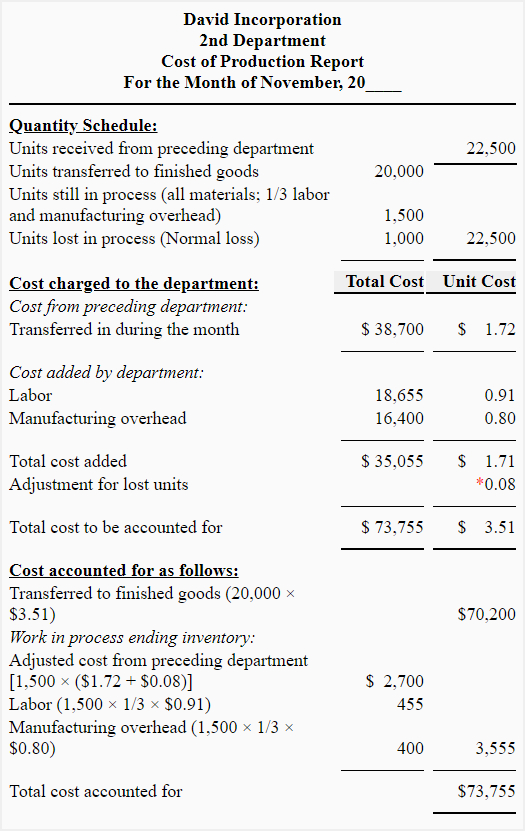It provides detailed information about the different cost components involved in the production process, including both direct and indirect costs. Work-in-progress (WIP) is the cost of unfinished goods in the manufacturing process. This includes all your production costs such as the costs of direct labor, raw materials and manufacturing overhead. This differs from finished goods, which are products ready to be sold to the consumer. Keep in mind that any fixed or variable costs you include must get incurred while producing your product or service. Just add the total fixed costs from a specific period of time to the total variable costs over the same period.
Capacity Utilization

Generate status, workload, timesheet, variance and other reports in just a keystroke. All reports can be filtered and shared with stakeholders to keep them updated. Production costs might vary depending on your type of business and the industry that you’re in. These include fixed costs, variable costs, total costs, average costs, and marginal costs. To determine the average cost, you simply divide the total cost of production by the total unit of output.
- All of these costs are added up to come up with the total production costs.
- In Process Costing, the wip inventory accumulates the costs of all units that were started and completed during the period, but had not been transferred out of the department as of the end of the accounting period.
- This differs from finished goods, which are products ready to be sold to the consumer.
- The mixing department started another 3,250 shells during February, and at the end of the month, there were still 1,000 shells being mixed and prepped for baking.
- To keep things simple, production costs are expenses incurred when producing your product or service.
- All such information is provided solely for convenience purposes only and all users thereof should be guided accordingly.
Reviewed by Subject Matter Experts
They are static documents that require manual updates and are poor collaborative tools. Upgrading to project management software provides greater control over production and, therefore, increases efficiency. ProjectManager is award-winning project and portfolio management software that can help manage resources and monitor costs and more to identify weaknesses and improve efficiency.
Step 2 – Calculate units accounted for
A production report will also include the production capacity utilization rate, any issues in the production line and how efficiently products are manufactured in terms of time, quality and costs. The main objective of a production report is to provide data that production managers can use for production management and optimization purposes. A cost of production report is a document used by manufacturers to calculate the cost of producing goods during a specific period.
Cost of Production Report (CPR) Questions and Answers FAQs
Now, check your understanding of the second or subsequent stage of a multi-step process using the weighted-average method of process costing. Production reporting is only one part of the larger production management process. For readers who care to go deeper into the subject, our site is national real tax tracking company profile an online hub for all things project management. We publish blogs, tutorial videos, free templates and more that address every aspect of managing a project and as it applies to many different industries. Here are a handful of links to stories about production management in manufacturing.
Why You Can Trust Finance Strategists
Following is a complete cost of production report that accounts for all the Balloon department’s units and costs. Under the weighted average method, costs transferred in from last month are added to this month’s costs and distributed across all units. This is the simplest way to account for beginning inventory costs, but not always the most accurate. For example, if costs are going up, the cost of those 750 pie shells in beginning work in process inventory would be less than the cost of the 1,000 pie shells in ending inventory. The 750 shells in production at the end of January were 60% complete as to conversion costs and 100% complete as to direct materials, so in February they will need 40% more conversion but 0% more direct materials. Production managers and their teams will soon experience their limitations.
Establish the total inventory in production by adding units started into production to beginning work in process (what was left only partially finished at the end of the prior month). For this example, we will assume that all pie shells in process were completed in December, and the facility was shut down over the holiday break for annual repairs, maintenance, and deep cleaning. So, the beginning inventory of zero plus the 2,250 pie shells transferred in from the mixing department during the month gives us a total number of units to account for of 2,250. A work-in-process inventory (wip) is an account that represents the cost of partially completed products.
Maintenance costs are all the costs related to the activities in your maintenance schedule. This metric helps production managers monitor the performance of a machine over time with the goal of optimizing equipment availability while keeping costs at a minimum. Maintenance unit cost is the total maintenance expenses required to produce one product unit during a specified period. To calculate maintenance costs, divide the total maintenance costs in a specific time frame by the number of products produced during that same time frame. Conversion costs refer to the direct labor and manufacturing overhead expenses incurred in the production process to convert raw materials into finished goods.
Dummies has always stood for taking on complex concepts and making them easy to understand. Dummies helps everyone be more knowledgeable and confident in applying what they know. We need just a bit more info from you to direct your question to the right person. Ask a question about your financial situation providing as much detail as possible.
A financial professional will offer guidance based on the information provided and offer a no-obligation call to better understand your situation. Someone on our team will connect you with a financial professional in our network holding the correct designation and expertise. Our writing and editorial staff are a team of experts holding advanced financial designations and have written for most major financial media publications. Our work has been directly cited by organizations including Entrepreneur, Business Insider, Investopedia, Forbes, CNBC, and many others. The articles and research support materials available on this site are educational and are not intended to be investment or tax advice. All such information is provided solely for convenience purposes only and all users thereof should be guided accordingly.
